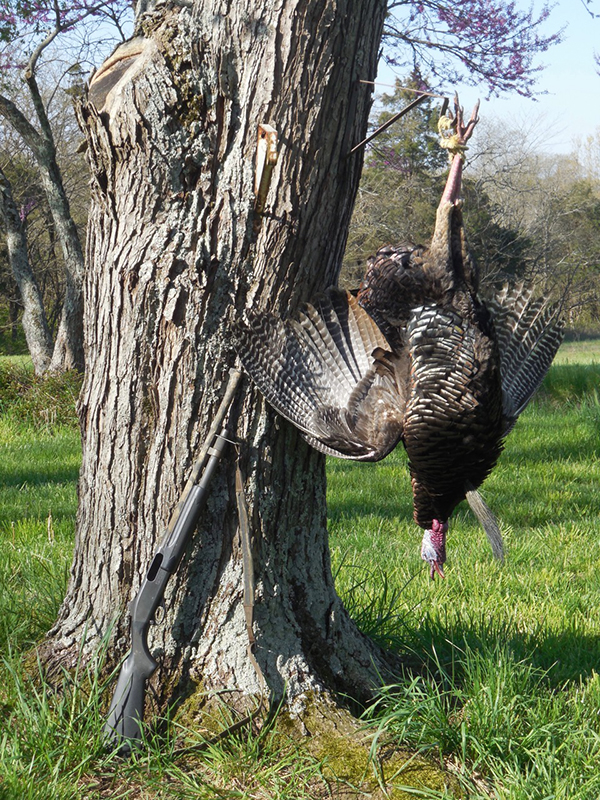Kentucky’s 2022 spring wild turkey season opens in two weeks.
Hunters are likely to take more turkeys than last season, provided there aren’t poor hunting conditions — prolonged periods of rain, or inclement weather.
“I wouldn’t expect a big jump,” said Zak Danks, turkey program coordinator for the Kentucky Department of Fish and Wildlife Resources (KDFWR). “But I think we’ll have a good harvest this year.”

The 2021 spring harvest of 29, 222 was a decrease from the 2020 harvest, and 4.2 percent below the five-year average of 30,519, based on information in the 2021 Kentucky Spring Turkey Season Summary. “The (factors for the) slight reduction in harvest (during the 2021 season) likely included Easter (on) the second day of youth season, inclement weather, rain, snow, and cold temperatures during the general season, Mother’s Day (on) the last day of turkey season, and COVID-19 recovery, more hunters returning to work with less time off.”
Although total harvest declined, hunters were more efficient last season, hunting about 3.25 days per turkey harvested. During the 2020 season, the time hunted per turkey harvested was more than 4.5 days. “These figures are based on responses by hunters who checked their turkey harvests online,” wrote Danks.
With no major regulation changes since 2006, Kentucky’s spring turkey harvest figures are comparable over a relatively long time span, giving biologists more confidence in observed trends.
During the past five spring seasons, the turkey harvest has been trending up and down in a range of 5,817 birds, from a high of 33,072 and a low of 27,255, based on harvest figures posted on the KDFWR website.
Danks said a reduction in the bag limit would only be considered if there were several years in a row of steep declines in the harvest during the spring season.
2022 Season Dates
Kentucky’s 23-day statewide general season opens Saturday, April 16, and continues through Sunday, May 8.
The two-day youth weekend, by regulation held on the first weekend in April, opens tomorrow and closes Sunday, April 3, 30 minutes after sunset.
Some 2021 Spring Turkey Season Harvest Highlights
• The top five counties in turkey harvest for the 2021 spring season were: Muhlenberg County, 622; Logan County, 606; Christian County, 553; Pulaski County, 530, and Hart County, 521.

• Turkey harvest decreased in four of the five Wildlife Division Regions, including a 14.7 percent drop in the Bluegrass Region. The only turkey harvest percentage increase, 10.1 percent, was in the Purchase Region.
• The percentage of hunters that harvested the statewide bag limit of two bearded turkeys was 25.8, a percentage that was virtually unchanged from the five-year average.
• The percentage of juvenile gobblers (jakes) in the harvest declined to 10.4 percent, from the five-year average of 13 percent. Danks wrote in the 2021 Kentucky Spring Turkey Season Summary that “hunters preferentially harvest adult gobblers….a (decrease) in the percentage of jakes taken may indicate more adults gobblers were in the population this (past season), reflecting decent reproduction in 2019.”
• Turkey harvest by youth hunters was 1,483, a 32.4 percent decline from the previous season and an 11.1 decline from the five-year average. “Easter was on the second day of the youth season, probably reducing hunting participation and effort,” wrote Danks.
• Harvest of turkeys on public land harvest increased by 14.0 percent.
• Nonresident hunters accounted for 26.7 percent of public lands harvest. In 2020, nonresident hunters harvested just 412 turkeys due to license sales restrictions and travel limitations during the COVID-19 pandemic. In contrast, the nonresident harvest increased to 3,768 during the 2021 season.
Poult Per Hen Ratio, an Indicator of Reproductive Success
Danks said he can’t overemphasize the importance of the turkey hatch to hunter success.
Since a majority of adult turkeys taken by hunters during the spring season are two-year-olds, an increase or decrease in reproductive success for a given year is typically reflected in the hunter harvest two years later.

Turkey reproduction in Kentucky is monitored by an annual brood survey, conducted during July and August, each summer since 1984.
Turkey observation reports from across the state are used to calculate the poult per hen ratio (PPH), the primary indicator of reproductive success.
Since 2017, biologists have standardized the way they calculate PPH, to foster consistency and comparability of results across states and regions.
A look back at the numbers reveals that turkey reproduction, while much improved in the short term, is considerably lower than the brood survey data from the past 15 years in Kentucky.
The drop in turkey reproductive success is not unique to Kentucky.
Local flocks in many states in the eastern U.S. have shown marked declines. Biologists in the region agree there are several causes for the declines, among them: lower poult production, nesting and brood-rearing habitat are not as good as they once were, carrying capacity has been reached in many areas, former pastures have been converted to grain production, and timber cutting has declined.
Danks said some states in the Southeast are really down while some states in the Midwest are up. “Kentucky is average to better than average in the (hatching) data.”
2021 Kentucky Wild Turkey Brood Survey Report
Here are some pertinent findings:

• The 2021 PPH was estimated to be 3.2 statewide, a substantial increase compared to recent years: 45 percent higher than 2020, 33 percent higher than 2019, 60 percent higher than 2018, and 146 percent higher than 2017.
• The 1.3 PPH in 2017 was the lowest on record, and 41 percent below the 10-year average between 2009 and 2017.
• By region, Western Kentucky’s PPH was 3.1, Central Kentucky’s PPH was 3.6, and Eastern Kentucky’s PPH was 2.6.
• Central Kentucky led the state in the number of observations, 240, and the total number of turkeys observed, 1,335, including 291 hens, 966 poults, and 72 male birds (jakes and adult gobblers).
• The percentage of hens with a brood was 77.9 of all observations statewide.
• Favorable weather conditions during the spring and early summer were important factors in the high PPH in 2021 and contributed to high poult survival.
The National Weather Service (NWS) in Louisville reported little severe weather in April and May when turkey hens were nesting, with temperatures and rainfall slightly below normal.
“Dew points remained low, even during warm spells, so it wasn’t very humid, and morning lows were in the 60s,” the NWS reported on their website. Hens are more susceptible to predation while sitting on the nest during humid conditions, which improves scenting conditions for predators.
A warm, dry period in late May encompassed much of the hatching period, so conditions were ideal, especially in the Central Kentucky region.
Above-average rainfall in July fueled vegetation growth, providing cover and insects for poults.
Now is the time to prepare
Get ready for the spring turkey season now.
Listen for gobbling early in the mornings in your hunting area and use binoculars to discreetly monitor fields for hens and gobblers.

Fields are greening up fast, providing turkeys with lots of food options — grasses, clovers, winter wheat in crop fields, and tender forbs in woodland edges.
Organize your gear — calls, camouflage clothing, vests, face masks, gloves and hats and put everything in a plastic storage tote.
Treat your camouflage clothing with insect repellent.
Hang your clothing outside and spray with Sawyer Premium Insect Repellent, which repels and kills ticks, chiggers and mosquitoes. It’s odorless, won’t stain clothing and lasts for six weeks.
Shoot your shotgun at a turkey head target to ensure that it’s sighted in and familiarize yourself with your shotgun’s effective range, based on the load you are going to hunt with.
2022 Spring Turkey Season Regulations
Visit the KDFWR website to get all the details on the 2022 spring wild turkey season.
Wild turkey activity cranks up in the spring when dominant gobblers collect a harem of hens, and hens begin nesting. Photoperiod (length of daylight) is the trigger for breeding.
Turkey hunters feel a rush of excitement when they hear a lovesick tom gobbling his head off at the crack of dawn.
Don’t miss out on witnessing the wild turkey’s passion play, a spring mating ritual that is unsurpassed in drama and suspense.






















Turkey hatchling numbers are way way down,dont wait until its too late, like the silver asian carp problem, fix it now ,